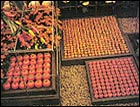Guide to growing tomatoes
Stephen gets to grips with growing a varied selection of tomatoes, chillies, peppers and gooseberries


At Titsey Place, we have recently finished planting all the outdoor tomatoes, which were grown from seed sown in mid-April. I only select cordon varieties, which are trained up a single cane, because they are much more controllable than bush varieties; they yield well, but have a much neater appearance in the garden. We put them in rows either side of one of the turf paths so that, in due course, they will form a brightly coloured 'tomato avenue', which is quite decorative.
We grow about 32 tomato varieties, planting out two of each kind; some are reliable favourites, such as Yellow Butterfly (small, plum-shaped); Juliet?a very sweet, cherry-plum?and Soleane, which also has excellent flavour. Others are new to us. This year, we sowed a selection of the Del hybrid series: Albadel (a near-white), Rosadel (blush-rose) and Daffodel?which will be unsurprisingly, a bright yellow. Mixtures of their differently coloured fruits look terrific in salads.
All our tomato seeds come from the specialists, Simpson's Seeds of Warminster, Wiltshire (www.simpsonsseeds.co.uk), which stocks a huge range. The catalogue is interesting to go through if you want obscure varieties such as purple, striped, white, or special flavours. I sow half a dozen seeds per 3in pot, and when they germinate, the three best seedlings are pricked out and put singly into 3in pots. Once they have grown on in the greenhouse for 4 to 5 weeks, they then go out into the cold frame for another two weeks to acclimatise, before being planted out. Even so, this spring, the frames have been left open all the time, as there haven't been any nights cold enough to require closing them up.
Once the cordons are growing well, tie the main shoot to the cane and pinch out the side shoots regularly?every four to five days?because they grow rapidly. Here, an irrigation system drips water directly to the roots of each plant. It is worth installing one, as it is an efficient and economical way of using water?an hour or so, every couple of days during dry spells, is enough. They also get regular feeds of potash-rich tomato food, which are automatically dispensed the same way
Elsewhere, chillies and sweet peppers have also just been planted out, 18in apart, and again, they are in rows lining a path to make a colourful avenue. Last year, they produced a huge harvest due to the hot summer. The chillies have descriptive names, and this year at Titsey Place you will see Condor's Beak, Bulgarian Carrot, Sweet Cayenne, Sweet Chocolate, Big Bertha, Cayenne Long Red, and an African Scotch bonnet type called Safi, to name a few. We are also trialling Aji Hot and Aji Yellow: they grow to 6ft tall, apparently, and have, therefore, been placed at the ends of the rows. Chilli peppers are self-branching, so pinching out shoots is not usually necessary, and we have always found them to be pest and disease free?a truly easy kitchen-garden plant, in other words.
The gooseberries are grown against a north-facing wall, trained as triple cordons, so each plant makes three parallel vertical branches. Cordon-training gooseberries is the sort of thing you have to do yourself with young plants?you cannot buy them ready-trained, as far as I know. But it is a good thing to do, as you get an excellent crop, and they are easy to pick as you don't have to bend down to reach them, or reach into scratchy bushes.
In mid-June, we are spurring back the gooseberries (pruning off the straggly growths that have grown out beyond the developing fruits) to let air and light reach the berries. It also makes the job of picking the fruits much easier. The gooseberries grown here are Pax, a red dessert variety with the most amazing flavour, more like a currant?you can even eat it raw; Careless, a green early variety with dependable crops; and Rokula, another good red dessert type, fruiting early.
Exquisite houses, the beauty of Nature, and how to get the most from your life, straight to your inbox.
Stephen Tett is head gardener at Titsey Place, Oxted (01273 715362 or 01273 715359; http://www.titsey.org). Garden opens May 9 to September 30, Wednesday, Sunday and Bank Holiday Mondays, 1pm to 5pm.
Country Life is unlike any other magazine: the only glossy weekly on the newsstand and the only magazine that has been guest-edited by His Majesty The King not once, but twice. It is a celebration of modern rural life and all its diverse joys and pleasures — that was first published in Queen Victoria's Diamond Jubilee year. Our eclectic mixture of witty and informative content — from the most up-to-date property news and commentary and a coveted glimpse inside some of the UK's best houses and gardens, to gardening, the arts and interior design, written by experts in their field — still cannot be found in print or online, anywhere else.
